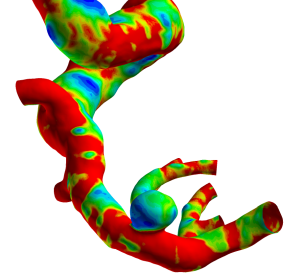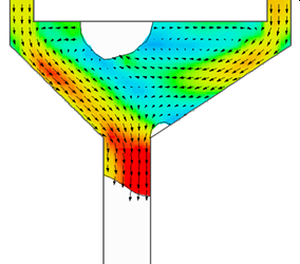CFD in medical technology
In medical technology, flow processes are often decisive: blood, NaCl solutions, disinfectants, air and oxygen are typical fluids. On the one hand, these fluids flow in the human body, on the other hand through technical apparatus such as pumps, artificial heart valves, hose lines, respirators, nebulizers, inhalers, dialyzers, etc. Active substances are dissolved and should be placed in a targeted manner, disinfectants must be used safely yet sparingly, air must be purified, oxygen must be supplied.
On the one hand, the individual shape of blood vessels, for example, plays a major role, while on the other hand, in the development of medical devices it is often details such as production-related gaps or trapped air bases that determine success or failure.
In both cases CFD calculation models provide the necessary insight:
In personalized medicine, for example, the blood vessels of a patient are recorded using imaging techniques and, based on this, a flow simulation is carried out. The result is the blood flow in the individual vessels under consideration, with all local and time-dependent pressures, shear stresses, vortices, backflow and “dead water areas”. The picture on the right shows an example of the blood flow through a cerebral vessel of a patient with a cerebral aneurysm (here you can find our detailed blog post about aneurysm).
Postprocessing with FIELDVIEW
CFD models are an essential part of virtual product development in the development of medical devices. The fluidic function can be checked and optimized, problem areas can be analyzed in detail. This reduces the development risk while increasing product quality. With today’s simulation methods, moving components, smallest gaps, multi-phase flows, mixing and segregation processes, particle and droplet loading, heat transfer and reactions can be represented in almost all size scales. The picture on the right shows e.g. undesired air inclusions (white areas) that form when filling an apparatus. Geometrical factors play an important role here. Physically, the shape of the free surfaces is strongly influenced by the surface tension between liquid and air and by the wall contact angle.
We have been developing such calculation models tailored to the needs of our customers for over 20 years. We combine their specific expertise with our simulation know-how and our physical understanding. Through participation in research projects and cooperation with universities and software providers, our methods are always state-of-the-art.
Contact: Volker Kassera, CFD Consultants GmbH




